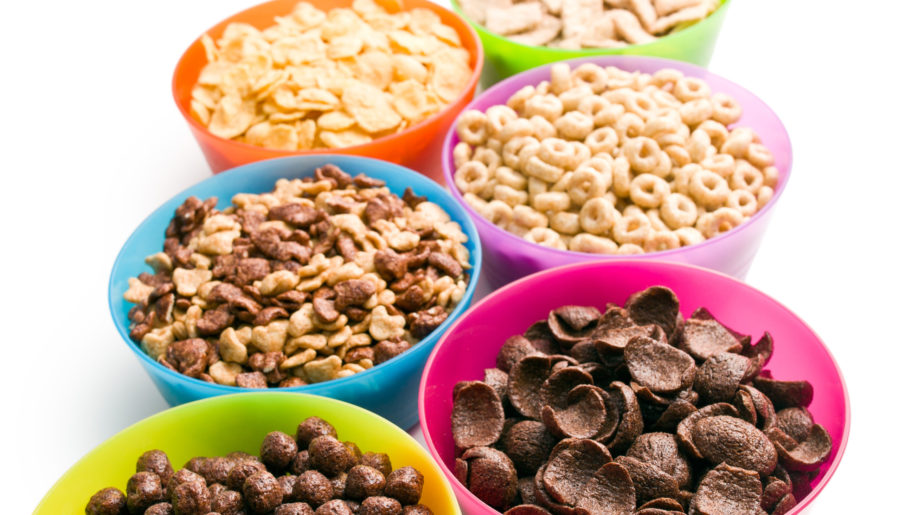When it comes to busy mornings, nothing is quicker and easier than having a bowl of cereal. A stroll down the cereal aisle suggests that there are many healthy cereal options. Unfortunately, labels are highly misleading—breakfast cereals can be highly processed and often packed with added sugar and refined carbohydrates. March 7 is National Cereal Day, so let’s discover how to choose a healthy cereal.
Watch out!
Some of the most popular breakfast cereals out there today—many times marketed to children or as “healthy”—contain unhealthy or potentially toxic ingredients. Nutrition experts from the University of Pittsburgh Medical Center advise that the cereal you choose should be made from a short list of easily recognizable ingredients.
Added sugar is probably the most common harmful ingredient found in many cereals. Potentially labeled as sugar, high fructose corn syrup, corn sugar and evaporated cane juice, added sugars have been linked to chronic diseases like Type 2 diabetes and obesity. A study published in the Journal of the American Medical Association found an association between a high-sugar diet and a greater risk of dying from heart disease.
Other hidden dangerous ingredients include hydrogenated oils, which contain saturated and trans fats, as well as artificial colors and flavors. Testing performed by the independent Environmental Working Group found that many popular cereals contain traces of glyphosate, an herbicide that is the main ingredient in the weed killer Roundup.
Look for…
So, is there hope for a healthy breakfast cereal? University of Pittsburgh nutritionists advise that people can still find good-for-you cereals by looking for key factors.
Several ingredients are crucial when picking the best cereal: whole grains, sugar, fiber and protein. The first ingredient should be a whole grain, whether it’s whole wheat, whole oats or bran. Refined grains like white flour and degermed cornmeal have been stripped of most of their fiber, vitamins and minerals. Grains with the word “whole” in front of them may help reduce the risk of heart disease and cancer.
Sugar should NOT be listed as one of the first three ingredients listed on the nutrition label, and the cereal should ideally have no more than six grams of sugar per serving. Stick with unsweetened varieties over flavored ones. Added sugars are to be avoided at all costs as they typically turn cereal into a dessert.
Look for cereals with at least three to five grams of fiber and five grams of protein per serving, as both ingredients can help you feel fuller longer. Fiber helps with digestion, works to improve cholesterol levels and can keep blood sugar levels under control.
Serving sizes are also important. Eating a bowl of cereal doesn’t mean consuming a whole bowl is healthy! Typically, ready-to-eat cereals range from 3/4 to 1 1/2 cups, and granolas are usually around 1/3 cup. If the serving size isn’t filling enough, consider adding healthy additions like sliced banana or a scoopful of berries.
Don’t forget the milk
Consider what goes on top of your cereal as well. While low-fat or skim milk are fine options, you can choose among a plethora of different milks to add flavor and give you a different nutritional boost. A few include:
● Almond milk, made with either whole almonds or almond butter and water, has a light texture and a slightly sweet and nutty flavor. One cup of unsweetened almond milk contains 30–35 calories, 2.5 grams of fat and one gram of protein.
● Coconut milk has a creamy texture and a sweet but subtle coconut flavor. One cup contains 45 calories and four grams of fat, one-third the calories of cow’s milk, half the fat and significantly less protein and carbohydrates.
● Oat milk is naturally sweet and mild. One cup contains 140–170 calories, 4.5–5 grams of fat and 2.5–5 grams of protein.
Healthy Cereals that will fill you up with the right ingredients
Barbara’s Original and Cinnamon Puffins
This cereal is lightly sweetened, high in fiber, dairy-free and wheat-free. One serving has 90 calories, five grams of fiber, five grams of sugar and two grams of protein.
Seven Sundays Wild and Free Blueberry Chia Muesli
This tasty muesli has chewy fruits, crunchy chia and buckwheat, and it is sweetened only with honey and fruit. One serving is 240 calories, six grams of fiber and eight grams of protein.
Bear Naked Vanilla Almond Fit Granola
This cereal features a mix of oats, almonds, brown rice and flaxseed with natural vanilla flavor. A serving delivers 210 calories, five grams of fiber and six grams of protein.
Grape Nuts
This cereal staple is low in sugar, high in fiber and contains no syrups and preservatives. With a simple list of ingredients, Grape Nuts is full of vitamins and minerals. One serving is 210 calories, seven grams of dietary fiber and five grams of sugar.
Kashi Go Peanut Butter Crunch Cereal
This peanut-buttery soy-based cereal features crunchy clusters with peanut buttery goodness. One serving is 220 calories, six grams of fiber and 10 grams of protein.
Cascadian Farms Purely O’s
This cereal is a great organic alternative to Cheerios. One serving has 140 calories, four grams of fiber and four grams of protein.
Related articles
Processed Foods: What You Need to Know
Cooking School 101: It’s Never Too Late to Learn
Forget Everything You Know About Your Metabolism
Ho’oponopono: An Ancient Hawaiian Path to Forgiveness

